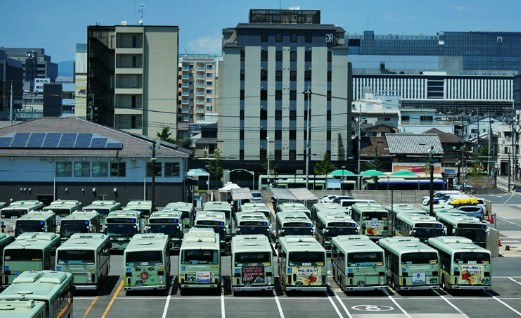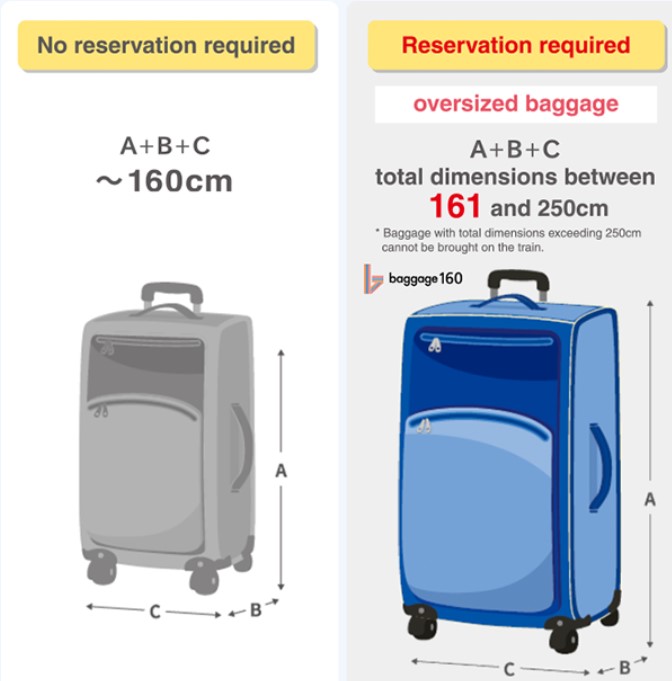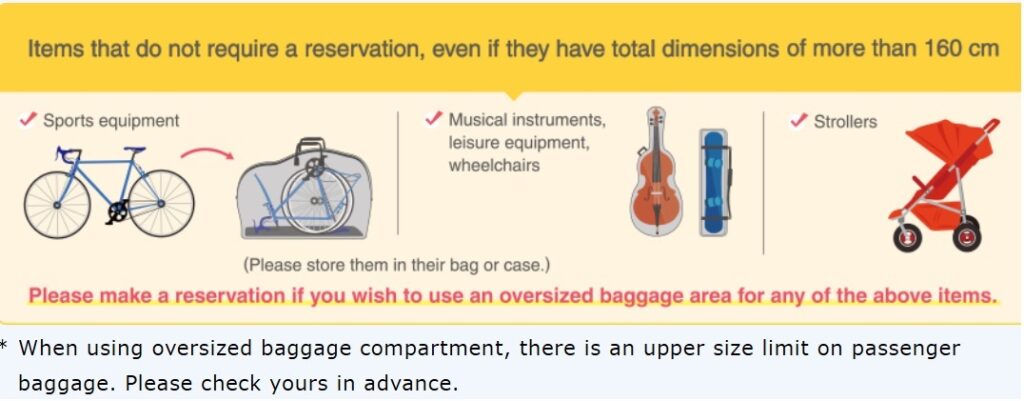Are you planning to visit Japan during the holiday season and travel around several places using public transportation? If so, what will you do with your suitcases when moving by bus or train from the airport?
With the increase in overseas tourists coming to Japan, complaints about troubles with overseas tourists are often heard by the locals. One such recent issue is about public transportation since foreign tourists are often unfamiliar with Japan’s general or local rules. For example, people living in Japan know they should not talk on the phone while they are on public transportation. Most of us turn on silent mode and communicate with text messages until we get off the train or bus. However, foreigners who come to Japan for the first time do not know this rule, so they often talk loudly without regard for other passengers on the train.
In popular tourist places, a different problem has bothered locals. In Kyoto, large suitcases brought in by tourists on city buses and left on the aisle block passengers from moving to a seat, cause crowding, and prevent local residents from getting on a bus. Shall we take a closer look at this problem?
Over-crowded Kyoto City buses
Kyoto’s city buses are a convenient way to explore the city, especially for accessing temples, shrines, and other attractions not near train stations. However, they can get very crowded, especially during peak tourist seasons, weekends, and rush hours.
This isn’t a new problem. When I travelled to Kyoto around 20 years ago, the number of foreign tourists visiting Kyoto was much fewer than today. But city buses were already packed with Japanese tourists on weekends (they did not bring suitcases, though).
First, I’d like to share some helpful information on how to navigate and manage your ride on a crowded city bus in Kyoto:

写真協力 フネカワフネオ photo53.com https://photo53.com/bus.php
Tips for Riding a Crowded Bus in Kyoto
- Plan Your Trip to Avoid Crowded Times
Usually,7:00–9:00 AM and 5:00–7:00 PM on weekdays are commuter times. So, try to avoid these hours for travelling by city buses and visit attractions early in the morning or late in the afternoon to avoid the rush.
To board and exit, in most Kyoto city buses, passengers enter the bus from the back door and exit through the front door. Pay your fare or tap your card when exiting, not when boarding. Make sure your IC card has enough money in it and complete the payment when you get off the bus (the bus driver should inform you when your IC card runs short of money)
2. Pack Light
Avoid carrying large luggage or bulky items. Storage space in city buses is limited. But leaving your luggage on the aisle blocks other passengers.
3. Be Mindful of Etiquette
After you get on the bus, move towards the back after boarding to allow others to get on. Keep your voice low and avoid using your phone for calls.
4. Alternative Options
Consider using the subway and trains instead of city buses for faster travel to some destinations, like Fushimi Inari or Arashiyama.
5. Crowded Bus Hacks
Use a Kyoto Bus Map or Google Maps to find alternative routes or lesser-used bus lines.
These bus lines are often crowded:
- Route 100: To Kiyomizudera, Gion, and Ginkakuji.
- Route 101: To Nijo Castle and Kinkakuji.
- Route 205: To Kyoto Station and Kinkakuji.
Also, consider taking a taxi for short distances if the bus is unbearably crowded. It often saves time and stress in Kyoto!

Tourists’ suitcases issues
In fact, Kyoto City Buses and Kyoto Buses have a rule about the maximum luggage allowed in buses by the “Kyoto City Passenger Vehicle Transportation Agreement”. It says that the weight limit is 10 kg, the total volume must be 0.027 cubic meters or below, and the total linear dimensions should not exceed 100cm. This is smaller than the size of carry-on luggage that most airlines allow to bring into the cabin. However, there is no penalty for violations because the allowed luggage size is too small, and the penalty would affect the daily life of the citizens; carry-on bags for short business trips or junior or high-school students’ large sports duffle bags would be oversized. This makes the size restriction impracticable.
In response to complaints from the citizens, Kyoto City asks travellers carrying large suitcases to use subways or railways instead of local buses. In addition, Kyoto City Tourism Association launched a website, ‘Hands Free Kyoto’, to provide solutions for travellers’ luggage issues on city buses. The website provides information on services to visitors who travel around Kyoto without suitcases or bulky luggage, such as luggage delivery services, luggage storage places, or locations of large lockers.
Please check the website and see the options you can use for your suitcases if you plan to visit Kyoto!
https://hands-free.kyoto.travel/?lang=en (Hands Free Kyoto website)
Oversize luggage storage issue in Shinkansen
Other than buses, tourists also travel by rail. The world-famous Shinkansen (bullet train) is a good way to travel around Japan efficiently. Its speed can reach 320 kilometres per hour, offering a fast and comfortable trip. It connects Tokyo with major cities such as Nagoya, Osaka, Kyoto, and Fukuoka. By Shinkansen, visitors can travel from Tokyo to Kyoto in less than 2.5 hours and to Osaka in around 2 -3 hours.
According to Central Japan Railway Company (‘JR Central’), oversized luggage is defined as luggage whose sum of height, width, and depth exceeds 160 cm but does not exceed 250 cm. This size is generally equivalent to the size of international airline check-in luggage.

(from the Central Japan Railway Company’s website) https://global.jr-central.co.jp/en/info/oversized-baggage
Each passenger can bring up to two pieces of luggage, not including smaller personal items like purses or laptops. Luggage of total liner dimensions exceeding 250 cm or weighing more than 30 kg is not allowed.
Passengers with oversized luggage with total liner dimensions of more than 160cm and below 250cm need to make special arrangements when travelling on the Shinkansen in Japan. Here’s what you need to know:
Reservation required for passengers with oversized luggage:
Passengers with oversized luggage must reserve a “seat with oversized luggage area” when booking their tickets. This type of seat is located at the back of certain cars (please refer to the image below and the Central Japan Railway Company’s website page) and includes a designated space to store your oversized luggage securely.
There is no extra charge for the oversized baggage reservation if you book the appropriate seat in advance. However, if you do not reserve the seat with oversized luggage area and bring oversized luggage onboard, you may be charged an additional fee of 1,000 yen and be asked to store the luggage in a specific area.

(From Central Japan Railway Company’s website page: the location of the special seat with oversized baggage storage)
https://global.jr-central.co.jp/en/info/oversized-baggage/ (Central Japan Railway Company)
For smaller items under 160 cm in total linear dimensions, you can bring them onboard without any special arrangements. Standard luggage racks above the seats accommodate smaller bags.
However, there are some exceptional items that passengers are allowed to be brought in without the arrangement of a seat with oversized luggage area. If you’re travelling with very large items, such as a folding bike (in storage case), musical instrument, wheelchair, or stroller as long as they are folded and can be stored near your seat. Of course, you also can reserve a seat with oversized luggage storage and keep the item. Alternatively, you may consider using Japan’s convenient luggage delivery service (takkyubin) to send large items ahead to your destination.

(From Central Japan Railway Company’s website page: the location of the special seat with oversized baggage storage)
Would you like tips on reserving these seats or alternatives for managing oversized luggage?
Here are some tips for reserving seats with oversized baggage areas and alternatives for managing your luggage when travelling on the Shinkansen in Japan:
Reserving Seats with Oversized Baggage Areas
How to Book: You can reserve these seats when purchasing your tickets online, at ticket machines, or at JR ticket counters (Midori no Madoguchi). Be sure to specify that you need a seat with an oversized baggage area. It is usually marked clearly on online booking systems or by the staff when booking in person. These seats are located at the back of specific cars, often near the luggage storage area.

(from the Central Japan Railway Company’s website) https://global.jr-central.co.jp/en/info/oversized-baggage
Which Shinkansen Lines Support This?
The oversized baggage rule applies to major Shinkansen lines, such as the Tokaido, Sanyo, and Kyushu Shinkansen, and others. Some regional or less busy lines may not have strict rules, but it’s better to check beforehand.
Alternatives for Managing Large Luggage
a) Use Luggage Delivery Service (Takkyubin)
Japan’s takkyubin services (offered by companies like Yamato Transport or Sagawa Express) are incredibly reliable and allow you to send your luggage to your destination (e.g., hotel or airport).
The advantages of using the service are that you can avoid carrying large luggage through crowded train stations and travel with Shinkansen (or local trains) without hassles. Same-day or next-day delivery is available depending on the distance although it usually takes a couple of days for delivery. Prices are based on luggage size and distance, typically 2,000–4,000 yen per piece for standard sizes. You can drop off your luggage at service counters in airports, hotels, or convenience stores and arrange the delivery.
b) Use Coin Lockers or Luggage Storage
If you don’t need your luggage immediately, coin lockers are another option for storing it for one or two days. Fees for coin lockers vary depending on the locker size and area. Coin lockers are placed at (or near) many train stations. In addition, many major Shinkansen stations offer baggage storage services for larger items.
c) Pack Light or Downsize
Consider using smaller luggage that fits within the 160 cm size limit for overhead storage. Lightweight packing can save time and hassle.
| Total linear dimensions (A+B+C) | |
| ~160cm | Storage reservation is not necessary |
| 160~250cm “Oversized Luggage” | “Seats with an oversized baggage area” or “Seats with an oversized baggage compartment” ※Reserve the seat in advance |
| 250cm~ | Not allowed |
Key takeaways
Luggage troubles for overseas tourists on Japan’s public transport are common due to the country’s compact infrastructure and high passenger volume.
Challenges with Luggage on Public Transport in Japan
- Crowded Trains and Buses
Trouble: During rush hours (typically 7–9 AM and 5–7 PM), public transport is extremely crowded, leaving little to no space for large luggage.
Tip: Avoid travelling with luggage during peak hours. If unavoidable, aim for less crowded carriages (e.g., those at the front or end of the train).
- Limited Storage Space on Trains
Trouble: Local and rapid trains often lack designated luggage storage areas. Overhead racks are designed for smaller bags, and large suitcases can obstruct aisles.
Tip: Use Shinkansen (bullet train) with reserved seats offering extra luggage space. Some Shinkansen now have dedicated oversized luggage areas, but you need to reserve in advance.
- Restrictions on Oversized Luggage
Trouble: For Shinkansen, luggage exceeding 160 cm in combined dimensions requires a reservation in a special storage space (no extra fee for the reservation!). Without a prior reservation, you may face additional fees or even be denied boarding.
Tip: Check your luggage size and book accordingly. Use luggage delivery services (Takkyubin) to send large bags directly to your destination.
- Coin Locker Availability
Trouble: Coin lockers, commonly found at train stations, fill up quickly, especially at major stations or during busy seasons.
Tip: Arrive early to secure a locker after finding available lockers nearby using digital apps (such as ‘Spacer’ https://spacer.co.jp/en/user/ or ‘Bounce’ https://bounce.com/)
- Narrow Spaces on Buses and Trams
Trouble: Local buses and trams, especially in rural or tourist-heavy areas, often have no storage areas, making large suitcases inconvenient.
Tip Opt for long-distance buses (e.g., highway buses) with undercarriage storage for larger luggage.
General Tips for Managing Luggage on Public Transport in Japan
- Pack Light: Consider traveling with smaller bags or backpacks for ease of movement.
- Luggage Delivery Services: Use Takkyubin or similar services to ship your luggage to your next destination.
- Plan Routes: Use apps to avoid overly complicated transfers at stations with limited accessibility.
- Travel Smart: Board trains or buses during off-peak hours and consider taxi services for shorter trips if luggage is cumbersome.
Understand the issues related to travelling on public transportation and take advantage of Japan’s well-organized systems. Minimize luggage-related stress and explore the country!!
